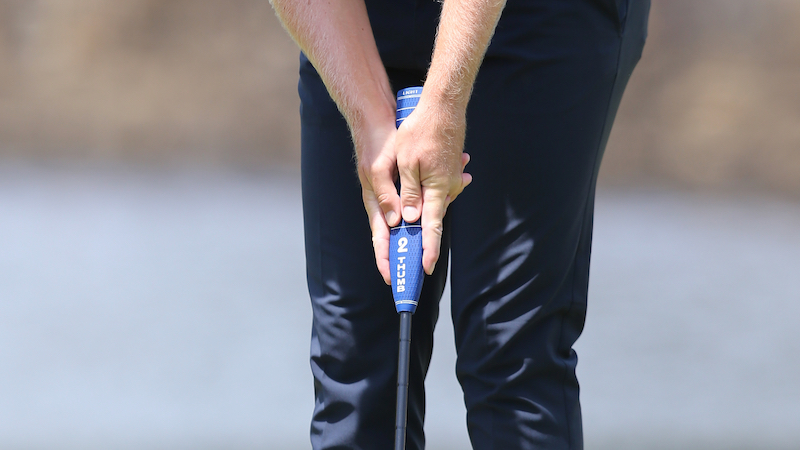
Understanding how to grip a putter is one of the key fundamentals in golf, but it can be difficult to know where to start. Getting the right 'feel' for you often comes down to a matter of trying each and deciding which fits best, something you can do very easily at home on a putting mat or using one of the best putting aids.
Ensuring you have the best putter in your bag provides its own advantages, but ultimately it's about how you wield the club that will dictate the results on the green. Before you make any permanent changes with your grip, try out some of the best putting tips and putting drills to experiment with different styles – it's the only way to know for sure which suits you best as an individual.
To help you kickstart your investigation, we asked Golf Monthly Top 50 Coaches Katie Dawkins and Andrew Jones to share the most popular putting grip variations...
How To Grip A Putter: Conventional

You might feel completely comfortable executing the perfect golf grip with your driver or irons, but there is a little more room for creativity when it comes to the flat stick.
The most common method is the traditional right-hand-below-left grip, which most golfers start off with and continue to use successfully. Some of the best players ever have used this grip (think Tiger Woods or Rory McIlroy for examples of major success). As we grip our irons in much the same way, this conventional grip feels the most natural way to hold a putter.
The main difference is that, rather than holding the grip in your fingers as on a full iron shot, you grip the putter in your palms so they are looking skyward. This locks out the hands and encourages a hands-free pendulum action. Then, rather than interlocking your fingers underneath to unite the hands, use a reverse overlap position.
Place the index finger of your top hand over the cuticles of the bottom fingers. It will feel like you haven’t got a proper hold but that’s good as you can only use a rocking action from here, taking your wrists out of the stroke.
The Claw

The claw grip for putting is quite a radical method, but nevertheless very effective for those who master it. Place your left hand at the top in the conventional position (as outlined below), with your right hand then holding the putter grip between thumb and forefinger and your palm facing your body (top photo). This is another great cure for the yips, even if it looks a little odd. It can take a while for you to place your lower hand on the club in a way that feels comfortable.
Left Hand Low

If you are currently struggling with the conventional grip, then the left-hand-low style could be a switch that rids you of your woes. It really locks your hands and arms together to get you stroking your putts more solidly and consistently. It is simply a reverse of the traditional putting grip with the left hand below the right.
Major Champion Jordan Spieth, who is one of the best putters on the PGA Tour, uses this grip. The main benefit is that it helps to take unwanted hand action out of the stroke – an ideal cure for the yips, especially important on those shorter putts.
The Pencil Grip

The pencil grip sees the lower hand working in a completely different fashion, mirroring the way you would hold a pencil. It gives you the feeling of a much lighter grip in your right hand, with the palm working more towards the target. Again, the idea is to stop the right hand dominating. It keeps the small-twitch muscles out of your stroke and utilises the big core muscles to control things.
It also keeps your right side more connected to your torso with the right elbow tucked in against your side – something that can promote a more consistent stroke.
The Saw Grip

The saw grip, as you might imagine, is so-called because the right hand mirrors how you might grip and use a saw. The right-hand fingers sit on top of the grip pointing towards the target, with the grip sitting in the V between your right thumb and forefinger.
Unlike the pencil grip, it pulls the right elbow away from your body, so may not suit those who like to feel more connected to their torso. But it may prove a good option for those who like to feel more over the ball at address and who prefer a much straighter pendulum with less of an arc.
Armlock

The armlock grip is an option for those using longer-than-standard putters. It has been popularised by Matt Kuchar, Bryson DeChambeau and others.
With the putter locked against your forearm, it almost feels like you’re bowing the left wrist out. There’s absolutely no chance of it breaking down through the ball. Historically, both Kuchar and DeChambeau have employed a fairly conventional right-below-left, right-hand grip.
This style of grip typically de-lofts the putter, so you may need to move the ball further forward in your stance or have the loft on your putter adjusted a little. This one may suit those who feel mechanics rather than feel will help them hole more putts.
Oversize Putter Grips

Finally, oversize putter grips of varying sizes are now very common. While some may still work with one of the putting grips above, the fattest grips are better-suited to what is known as a two-thumb grip. Indeed, one of the company’s making such grips is TwoThumb.
These grips are so wide that both hands can sit together at the same level, with the thumbs sitting side by side down the front of the grip and the forefingers pointing down either side of the grip.
This is another grip that gets the shoulders level and allows a pure pendulum motion back and through. It can work well on faster greens but may prove a little trickier to master from long range on slower greens.
If a conventional putting grip is no longer working for you, why not experiment with one of these other options to potentially get your putting back on track?







